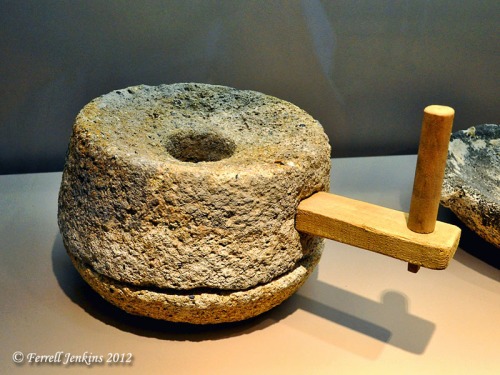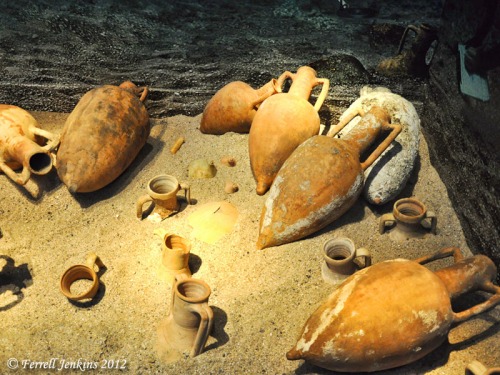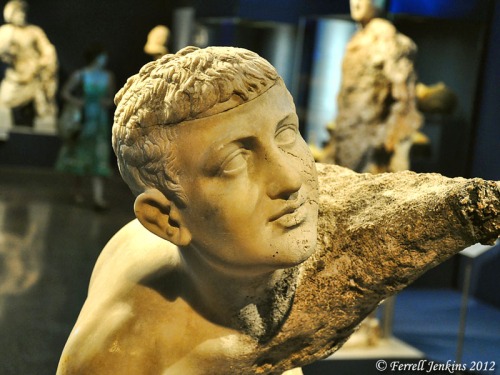'via Blog this'
The Antikythera Shipwreck and “Danger at sea”
The following post appeared in part on this blog June 4, 2012. I am repeating some of it for the benefit of those who missed it, and because it provides some complementary information for the study of Acts 27. A few changes have been made to make it more useful in connection with the Acts study.
The Antikythera Shipwreck is a special exhibition at the Athens (Greece) National Museum which is scheduled to run from April 2012 to April 2013.
The Ship and the TreasuresThe shipwreck off the eastern coast of Antikythera is dated to 60-50 BC, a period during which maritime trade and transportation of works of Greek art from the Eastern Mediterranean to Italy flourished. Its cargo dates from the 4th to the 1st century BC. The ship was a freighter of about 300 tons capacity and was sailing towards Italy.Bronze and marble sculpture luxurious glass vessels and golden jewellery, a large amount of pottery and bronze couches formed part of its cargo. Amongst these the famous “Antikylhera Mechanism” still contributes an enormous amount to our knowledge of ancient Greek technology and astronomy. All the finds recovered from the shipwreck bear witness to the aesthetic preferences of their orderers or potential purchasers but, above all, they reflect the new phenomenon of art trade, the first in the history of the West civilization.The MechanismConstructed in the second half of the second century BC, the Mechanism comprises gears, scales, axles, and dials. The inscriptions on the surface of the Mechanism refer to astronomical and calendar calculations, while the inscriptions on its metal protective plates contain instructions for its use. The Antikythera Mechanism is the earliest preserved portable astronomical calculator. It displayed the positions of the Sun, the Moon and most probably the five planets known in antiquity. It was used to predict solar and lunar eclipses, it kept an accurate calendar of many years, and displayed the date of Pan-Hellenic games (Olympia, Nemea, Isthmia, Delphi and Dodona.
We had visited Thera (aka Santorini) during our Aegean cruise. Antikythera (“opposite Kythera”) is a Greek island between Crete and the Peloponnese (where Corinth is located). This area is north of where Paul’s ship encountered the storm that drove it off course (Acts 27:8-16).
In the earlier post I included two of the sculptures being transported on the ship. Go here to see those photos. I will share some different photos today.
One display case deals with the “Self-Sufficient Microcosm.” In addition to cargo, there were a few human skeletal remains on the ship. Those who traveled by sea often had to take their own food supplies on board with them. It is thought that olives and snails were part of the daily diet. There were stones “for grinding seeds, liquefying vegetables and herbs, and stirring liquids.”
A manually operated quern was used for grinding grain.
Salted meat and fish, as well as olives, and wine could be stored for transport in amphorae and other containers. This display shows some of the amphorae as they might have been scattered on the sea bed.
Many of the sculptures found with the ship wreckage are encrusted with sea organisms. Be sure to see the previous post. There was one marble statue of a boy. The sign accompanying the sculpture says,
The boy is depicted nude and half bent-over with his head raised. The upper part of his torso leans sharply forward.
Some believe that this young man was preparing for wrestling. Others think he was a pancratiast (one who participated in both wrestling and boxing). Notice that the left side of the statue (our view on the right) is covered with sea organisms. The right side seems to have been buried in sediment on the sea bed, and thus protected.
Numerous bronze pieces are displayed. I especially like the one known as “The Antikythera Philosopher.” See the previous article.
We typically think of ships from the Roman period, and earlier, staying near the shore (coasters). This was certainly true of many of the sea journeys of the Apostle Paul (Acts 20:5, 13-16; 27:5-7).
Greek archaeologists announce here the discovery of two Roman-era shipwrecks in water nearly a mile deep. Sailing to Italy required leaving the safety of the nearby shore for deep waters. Such was true of Paul’s journey to Rome after leaving Crete (Acts 27).
Paul spoke of the dangers at sea in his second letter to the Corinthians (11:24-29) about A.D. 55.
- Three times I was shipwrecked.
- A night and a day I was adrift at sea.
- He mentioned “Danger at sea.”
The Malta shipwreck is the only one recorded in Acts, and it occurred after the writing of 2 Corinthians. Hughes mentions at least nine voyages between Acts 9 and 18. Paul says three of these ended in shipwreck. Hughes says there were at least another nine voyages between the writing of 2 Corinthians and the Malta shipwreck (The Second Epistle to the Corinthians, NICNT, 410-411).
At least some of the ships used by Paul were grain ships (Acts 27:38), but there may have been other cargo on some of them.
If you visit Athens between now and April 2013, be sure to take some time forThe Antikythera Shipwreck.




No comments:
Post a Comment